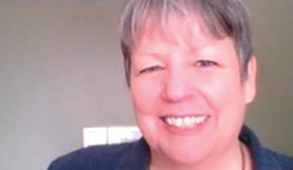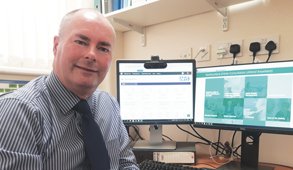Diagnosis for the future
Businesses often marvel at how slowly the NHS changes, tied, they say, to a plethora of business plans, seemingly endless committees and a bureaucratic approval process. Though the perception may have some truth to it – and there are often good reasons for NHS caution – during the Covid-19 pandemic the service has perhaps shed some of its reputation for glacial pace of change.
By necessity, changes have been made quickly. Hospitals have sprung up in a matter of weeks. Beds have been freed up and new testing systems created from scratch – though these measures have attracted criticism for their impact on patients and efficacy.
But one of the biggest changes visible to patients is the adoption of new ways of working, often driven by the speedy adoption of technology the NHS has been planning to use for years.
England’s health and social care secretary Matt Hancock and NHS England chief executive Simon Stevens have spoken warmly about the new ways of working, with Sir Simon insisting the health service must retain positive changes, such as new technologies around patient care, to support recovery of services.
The NHS has been promising to adopt technology that makes patient access easier and improve clinicians’ productivity for years. The NHS long-term plan – published in 2019 – commits to the wider use of technology and digitally enabled care, to reduce hospital visits and enable earlier discharge, for example.
The operational planning guidance for the current financial year – superseded by Covid – says many face-to-face outpatient appointments could be carried out using technology or are not needed at all. Tangible progress was expected during 2020/21, setting the NHS a goal of avoiding a third of face-to-face outpatient appointments by 2023/24.
Covid-19 has accelerated adoption of alternatives to face-to-face outpatient appointments and few would argue that tangible progress has not been made. The NHS England and NHS Improvement June board meeting heard that ‘substantial and accelerated progress’ has been made in redesigning outpatient care, in particular by using video and telephone consultations. More than 80% of trusts now have access to video consultation facilities, with more than 250,000 video consultations delivered across services in the year to date. This level of coverage already exceeds the goal the national bodies had set for this year and they expected further progress.
Board papers conclude that 46% of services were delivered virtually in March (post-lockdown) and April 2020, compared with just 6% in February and March (pre-lockdown). In primary care, most consultations were delivered via video/phone at the height of lockdown.
Many trusts use the Attend Anywhere web platform for video calls – NHS England and NHS Improvement have bought licences for all trusts until the end of the financial year. The national bodies offered providers training and up to £20,000 per provider to purchase equipment, though the latter is available regardless of the video consultation platform chosen by trusts. Video consultations would be reimbursed at the same level as face-to-face activity under old tariff rules. Attend Anywhere has also been used across Scotland, branded as NHS Near Me, since 2016.
Nuffield Trust researcher Rachel Hutchings says the pandemic has led to an acceleration of many ambitions for the NHS, particularly surrounding digital technology. ‘This is in areas such as online triage and remote consultations in primary and secondary care,’ she says.
The centre has also shown flexibility, as well as providing practical steps to support providers.
Challenges have included concerns about data privacy and the difficulties inherent in bringing together different and complex systems. ‘You have to get the infrastructure right, ensuring people have the right equipment and access to the internet,’ says Ms Hutchings.
Training and investment
The equipment will often involve capital spending, but there will also be revenue consequences. ‘Digital technology is not something you have as a one-off cost; it requires ongoing investment. You have got to keep on top of it.’
Clinicians must also be trained so they feel comfortable using it. The Nuffield Trust identified this in a 2019 report, says Ms Hutchings. ‘We said there is always going to be an underlying issue that technology spending isn’t a one-off, it’s also about the whole package around it, whether that be improving the technology or making sure there is investment in training and supporting staff.’
While coronavirus prompted trusts to seek alternatives to face-to-face meetings and appointments, the NHS phase 3 Covid response plan has provided further incentives. In the short term at least, there will not be a return to ‘normal’, and patients and clinicians will have to adapt.
As part of the Covid recovery, the NHS can no longer have waiting rooms full of people ready to see their clinician in person. Some patients will ‘come in’ to be seen, but many consultations will be over video or by phone call. And – as pointed out in the phase 3 guidance – some secondary care services will operate patient-initiated follow-ups where appropriate, allowing the patient to decide when they need to see a clinician.
Like all trusts, East Lancashire Hospitals NHS Trust is planning to meet the phase 3 requirements. Director of finance Michelle Brown (pictured) is the senior responsible officer for the trust’s outpatient improvement programme, examining options as it
seeks to restore services while taking account of the Covid-19 restrictions.
The trust is applying Lean methods – it is part of a national pilot on implementing Lean – as part of its improvement methodology. ‘We have an opportunity to use this in an innovative way. The phase 3 guidance is quite a challenge and we are working through that now,’ Ms Brown says.
Kate Atkinson (pictured below right), the trust’s associate director of improvement, is overseeing the programme day-to-day and says the Covid pandemic has accelerated the trust’s plans to introduce digital technology. ‘We did things in weeks that we had been planning to potentially take years.’
The trust is using the Attend Anywhere platform for its digital consultations, and, pre-Covid, had planned to roll out similar technology gradually. ‘Video appointments in physiotherapy and musculoskeletal are good examples of where the technology has worked well. The clinicians are able to demonstrate exercises to patients. Group consultations have also worked well,’ Ms Atkinson says.
The trust is currently reviewing the steps it took during the early phases of the pandemic in light of the phase 3 guidance, she says. ‘It’s really important to review things like virtual consultation, reflect on why we did it and ensure in the next phase it’s about doing the right thing.’
Jane McNicholas (above left), the trust’s deputy medical director and breast surgeon, says the contract payment system has not always facilitated alternatives to face-to-face appointments.
‘People wanted phone consultations for a long time, but bureaucracy and the payment system have been in the way – it’s not that people think it’s second best; they wanted to deliver outpatients in a different way and the coronavirus restrictions have enabled us to do that.’
Finance considerations
Ms Brown says the financial regime will have to consider the longer-term impact of the move to phone and video consultations to reinforce the changes. ‘The initial actions on funding at the beginning of the pandemic did what was needed day to day, allowing us the flexibility to keep staff safe and patients out of hospital. We have concerns that, going towards month 7, we don’t yet know what
the financial envelope will be, so that makes planning difficult. We are also concerned about the run rates being used to calculate any financial envelope, in that they may not reflect the future costs of living with Covid.’
Ms McNicholas adds: ‘Not knowing if the finance will be available makes it difficult, especially if we are trying to work on a backlog, such as in endoscopy where funding is required to change the model or to pick up extra work.’
The Nuffield Trust’s Ms Hutchings says the pandemic seems to have shifted clinicians’ attitudes on the use of digital technology.
’Something has changed to make it acceptable and this can be seen in other countries too. In New Zealand, for example, it used to be the case that you could not prescribe a medicine unless you had physically seen the patient. The country has now changed that regulation.’
Patient acceptance will be key to the ongoing adoption of the technology – with or without the restrictions imposed by Covid. In July, a Healthwatch survey of patients showed they were largely happy with the move to video and phone consultations.
Teams players
As well as patient-facing technology, trust staff have widely and enthusiastically adopted Microsoft Teams. Ms Atkinson says: ‘We had planned to roll it out as part of Office 365 from 1 April over a longer period, but with the need for social distancing and the number of people working from home, we were able to roll it out over a couple of days to about 10,000 users.’
Ms McNicholas says the Microsoft program has been a boon to the trust, allowing multidisciplinary teams (MDTs) to meet – the traditional approach of putting everyone in a room being out
of the question.
‘It’s enabled us to continue with less risk. MDTs are a big part of cancer long-term planning and Teams has enabled lots of good working – I don’t think we’ll ever go back.’
She adds that it improves productivity – for example, patients’ appointments can be accessed and booked during the MDT meeting while their cases are being discussed. Previously, these were booked by phone once the meeting was over. As a next step, putting the trust’s planned electronic patient record in place would allow meetings to have seamless access to notes too.
Ms Atkinson points out other benefits – for example, it has facilitated ongoing training for junior medical staff, including the recent induction for newly qualified doctors. Managers do not have to move between sites for meetings, increasing attendance.
‘We have used Teams to facilitate our business and we have evidence and feedback that it has improved productivity,’ she says. ‘Video calls have a downside in that you can’t recreate the relationships with patients or colleagues that you get with face-to-face contact.’
Technology has helped finance staff do their work during the Covid outbreak, enabling many to work securely from home.
Christine Hall, associate programme director at NEP – the not-for-profit NHS consortium that offers integral finance and procurement services – says its cloud-based system has shown its worth during the pandemic. NEP took steps in mid-March, before lockdown, to support its own staff to work from home. ‘We wanted to ensure business continuity so when lockdown came, we didn’t encounter any interruptions to service,’ says Ms Hall. ‘At the same time, we took on a new client – Newcastle Hospitals – so we don’t do things by half.’
The consortium moved its finance and procurement systems to the Oracle cloud around 20 months ago. ‘Without that transition from on-premises systems to the cloud we wouldn’t have been able to support our organisations as much as we have been able to,’ Ms Hall says.
‘It’s really come into its own during Covid. NEP includes general ledger, accounting to reporting, order to cash and purchase to pay. It has enabled accountants to manage their reports and submit accounts and returns.’
The NEP cloud is accessed securely via the internet, allowing access from anywhere, so working from home is so much easier. And the feedback has been positive.
‘Staff feel that being able to work from home using our NEP cloud has enabled efficient flexibility, and we feel we have supported our NHS colleagues through no interruptions of service,’ Ms Hall says.
She continues: ‘Particularly when the NHS is under pressure to deliver frontline care, its ability to continue with business as usual with essential back-office services has just worked for us.’
NHS Shared Business Services (SBS) has also worked hard to ensure back-office staff can do their jobs from home. The joint venture between the Department of Health and Social Care and Sopra Steria provides services to almost two-thirds of the NHS, such as payroll, finance, IT and procurement.
At the start of the UK response to the pandemic, in fewer than two weeks it ensured almost all of its 1,500 UK employees could work from home. At the same time, it continued to process weekly and monthly payrolls for almost 400,000 employees in 90 NHS organisations with minimal interruption. Its payroll team accelerated the processing of new and returning NHS staff.
SBS adds that it supported the temporary funding mechanism set up at the beginning of the financial year, which moved the NHS in England to block contracts, and helped trusts enable home working.
Stephen Sutcliffe (pictured), SBS’s director of finance and accounting, says: ‘Our top priority since the outbreak of Covid-19 has been to safeguard our own workforce, while ensuring that NHS employees are paid, orders are processed, NHS suppliers are paid and cash continues to move around the NHS.
‘Maintaining the level of support the NHS needs, whilst enabling homeworking on such a large scale, has required a monumental effort.’
Technology has always played a big role in NHS patient care and the diagnostic and monitoring equipment familiar in hospitals will be crucial in restoring services.
But the NHS will also need to continue to adopt new ways of communicating and working – not as ends in themselves, but as a way of facilitating the best care for patients.

From April to July 2020 almost 55,000 – nearly 60% of all appointments – were non-face-to-face, compared with just over 10,000 (7%) in the same period 2018/19.
The trust has been an NHS Improvement pilot site for the system since summer 2019, but its strategy aims to do more digitally to help it cover its large catchment area. ‘Some patients were travelling a long way for a five-minute consultation,’ says Nicky Moon (pictured), deputy director of commissioning, contracting and strategic programme.
Now he wants to consolidate and enhance the steps the trust has taken during the pandemic.
‘It is our strategy to reduce face-to-face consultations, and Covid focused everyone’s attention. We want to continue to embrace that and we wouldn’t want to go back to the old model of bringing everyone in.
‘Some patients will need to be seen physically, particularly when delivering bad news, but there are opportunities where patients can have non-face-to-face consultations successfully.’
The trust’s patient feedback shows a 96% satisfaction rate for non-face-to-face consultations. The shift to digital appointments has more than halved the average number of miles travelled per patient in two years to 7.2 miles. Other benefits include lower ‘did not attend’ rates.
The NHS phase 3 guidance asks for video and phone consultations to reach at least 25% as trusts get back to pre-Covid activity levels. ‘It will be a blended approach,’ Mr Moon says. ‘We need to build up to pre-Covid levels, but the model has changed in terms of interactions with patients.
‘We are working on a plan to increase our activity, making sure virtual consultations are part of that.’
He says the digital consultation targets in the phase 3 letter are ambitious and will be a stretch for some trusts. But he believes 25% is achievable for Northumbria Healthcare.
Outpatient appointments for maternity, psychological services (including child and adolescent mental health services and talking therapies), paediatrics and community services have been well-suited to the technology.
However, he says it may be more difficult to switch some of the more traditional specialties, such as cardiology, where physical examination may be required.
A small amount of funding (around £5,000) was given to the trust to begin the pilot – to buy hardware such as laptops, cameras and headsets – with NHS Improvement taking care of the Attend Anywhere licence costs.
Northumbria Healthcare has 91 waiting rooms in Attend Anywhere – each waiting room has a licence, with a cost attached (for NHS Improvement). Mr Moon says: ‘Not all rooms are being used continuously – 47 are used every day, but as we go forward, we will find out which ones we need.’
Related content
We are excited to bring you a fun packed Eastern Branch Conference in 2025 over three days.
This event is for those that will benefit from an overview of costing in the NHS or those new to costing and will cover why we cost and the processes.